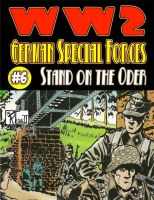
In Hitler’s Wehrmacht, the term “Special Forces” applied to something quite different from the Allied notion of an elite but small battle unit. The German “Special Forces” were composed of large independent battlegroups (or “kampfgruppen”) operating with their own artillery, tanks, and heavy weapons. They were designed to operate under special conditions—while not as big as a division, they were large enough to hold the line in an emergency, and then rapidly exploit any gains or weaknesses arising in the enemy lines.
The critical variable here was rapid response. Wehrmacht “Special Forces” were designed to take advantage of fleeting openings arising in the “fog of war” in battle. Another big advantage was flexibility; being able to assemble rapidly into a fighting force many small units which had become disconnected from their own division in the hectic brutal combat of World War 2.
By 1944 the Allies were marching inexorably into the heart of Germany and looming defeat was inevitable. But Hitler’s Special Forces moved rapidly from front to front, putting out an endless series of dangerous “fires”, in a desperate attempt to extend the life of Hitler’s “Thousand Year Reich” for yet another day or two…








































